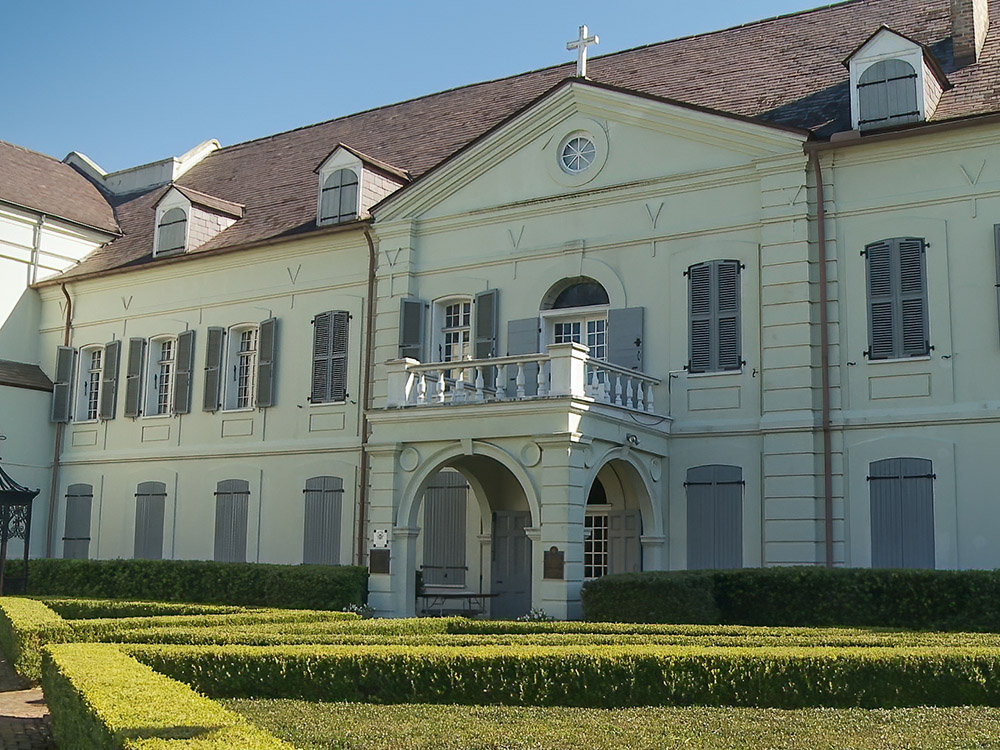New Orleans was a long ride by flatboat down the Ohio and Mississippi Rivers for a young Abraham Lincoln. It’s a journey Lincoln made twice to sell goods from the family farm in Indiana.

retracing the steps of lincoln in new orleans
Kevin Wood was making his annual visit to New Orleans when I met him near the Mississippi River on a foggy late January morning. Wood looks like Abraham Lincoln. And he dresses like Lincoln in a black suit, white shirt, bowtie and top hat. People driving by honk their horns, while those he passes on the sidewalk wave and ask for pictures. Wood is in character, doing his best to look and act Presidential. He smiles as he tells me, “I looked in the mirror one day and said, you look a bit like Abe.” Wood, who’s from Michigan, has worked full time as “Abraham Lincoln” for the past 8 years, doing history presentations for schools, churches and civil groups.

from midwestern farm to slave auctions
“Lincoln” walks to the corner of Chartres and St. Louis Streets, which was once the site of the St. Louis Hotel and Hewlett’s Exchange, one of the most active slave auctions in the city. He points to a historical marker on the side of the building and says, “I saw some of those enslaved people sold, men and women and children, too.” In 1828 and 1831, long before the real Abraham Lincoln was President, a young Abe made two trips by flatboat from his family farm in Rockport, Indiana, to New Orleans.

reconstructing history
Tulane University geographer and author Richard Campanella spent several years researching and tracing Lincoln’s New Orleans trips. Campanella explains that the young Lincoln did not keep a journal or diary of his two boat trips. But once Campanella figured out the timeline, he was able to find records of other things that Lincoln would have been exposed to on his river journeys. He created a detailed narrative of Lincoln’s likely experiences in his book, Lincoln in New Orleans: The 1828-1831 Flatboat Voyages and Their Place in History.

lincoln’s flatboat trips to new orleans
We stand along South Peters Street a few blocks upriver from the Mississippi River Bridges in New Orleans. This is where Campanella says the flatboats would have docked. The river steamboats and sailing ships would have been further downstream closer to the French Quarter. “There’s all sorts of activity here,” Campanella explains. This is where the flatboat crews were, “making deals with local merchants and wholesalers,” selling corn, wheat and smoke pork, typical items carried downriver from Midwestern farms.

Documenting slave auctions for lincoln’s visit
In his book, Campanella writes in great detail about the people who likely stood on the auction block and were sold to the highest bidder at Hewlett’s Exchange in New Orleans during the days that Lincoln was in New Orleans. “Probably the most significant aspect of Lincoln’s two trips to New Orleans would have been his first-person witness to large scale Southern plantation slavery, and large-scale slave auctions, the buying and selling of human beings,” Campanella explains.
lincoln in new orleans on tv
attacked by bandits
On his first flatboat trip to New Orleans in 1828, a 19-year-old Abe Lincoln and his partner Alan Gentry were victims of a night attack by bandits. “A club was landed on Lincoln’s right temple,” Campanella says. That beating left a scar on Lincoln’s head that could be seen for the rest of his life. Campanella believes the attack took place near the present-day town of Convent. After narrowly escaping the murder attempt, Lincoln and Gentry arrived in New Orleans the next day.


exploring Louisiana history
The post Lincoln in New Orleans appeared first on The Heart of Louisiana.


